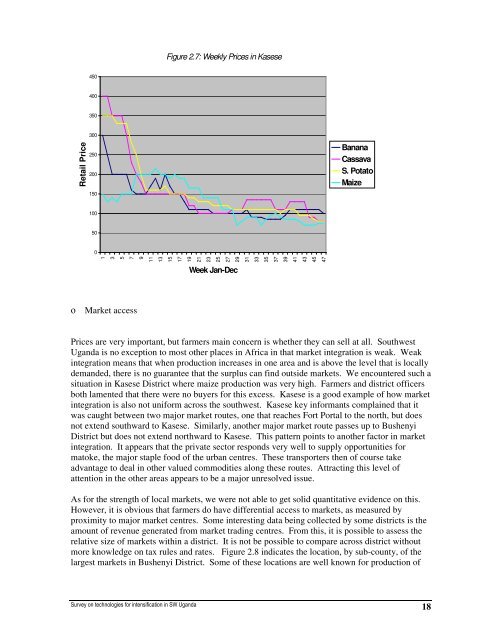Technologies for intensification in SW Uganda ... - Foodnet - cgiar
Technologies for intensification in SW Uganda ... - Foodnet - cgiar
Technologies for intensification in SW Uganda ... - Foodnet - cgiar
Create successful ePaper yourself
Turn your PDF publications into a flip-book with our unique Google optimized e-Paper software.
Retail Price<br />
450<br />
400<br />
350<br />
300<br />
250<br />
200<br />
150<br />
100<br />
50<br />
0<br />
Figure 2.7: Weekly Prices <strong>in</strong> Kasese<br />
1<br />
3<br />
5<br />
7<br />
9<br />
11<br />
13<br />
15<br />
17<br />
19<br />
21<br />
23<br />
25<br />
27<br />
29<br />
31<br />
33<br />
35<br />
37<br />
39<br />
41<br />
43<br />
45<br />
47<br />
ο Market access<br />
Week Jan-Dec<br />
Banana<br />
Cassava<br />
S. Potato<br />
Maize<br />
Prices are very important, but farmers ma<strong>in</strong> concern is whether they can sell at all. Southwest<br />
<strong>Uganda</strong> is no exception to most other places <strong>in</strong> Africa <strong>in</strong> that market <strong>in</strong>tegration is weak. Weak<br />
<strong>in</strong>tegration means that when production <strong>in</strong>creases <strong>in</strong> one area and is above the level that is locally<br />
demanded, there is no guarantee that the surplus can f<strong>in</strong>d outside markets. We encountered such a<br />
situation <strong>in</strong> Kasese District where maize production was very high. Farmers and district officers<br />
both lamented that there were no buyers <strong>for</strong> this excess. Kasese is a good example of how market<br />
<strong>in</strong>tegration is also not uni<strong>for</strong>m across the southwest. Kasese key <strong>in</strong><strong>for</strong>mants compla<strong>in</strong>ed that it<br />
was caught between two major market routes, one that reaches Fort Portal to the north, but does<br />
not extend southward to Kasese. Similarly, another major market route passes up to Bushenyi<br />
District but does not extend northward to Kasese. This pattern po<strong>in</strong>ts to another factor <strong>in</strong> market<br />
<strong>in</strong>tegration. It appears that the private sector responds very well to supply opportunities <strong>for</strong><br />
matoke, the major staple food of the urban centres. These transporters then of course take<br />
advantage to deal <strong>in</strong> other valued commodities along these routes. Attract<strong>in</strong>g this level of<br />
attention <strong>in</strong> the other areas appears to be a major unresolved issue.<br />
As <strong>for</strong> the strength of local markets, we were not able to get solid quantitative evidence on this.<br />
However, it is obvious that farmers do have differential access to markets, as measured by<br />
proximity to major market centres. Some <strong>in</strong>terest<strong>in</strong>g data be<strong>in</strong>g collected by some districts is the<br />
amount of revenue generated from market trad<strong>in</strong>g centres. From this, it is possible to assess the<br />
relative size of markets with<strong>in</strong> a district. It is not be possible to compare across district without<br />
more knowledge on tax rules and rates. Figure 2.8 <strong>in</strong>dicates the location, by sub-county, of the<br />
largest markets <strong>in</strong> Bushenyi District. Some of these locations are well known <strong>for</strong> production of<br />
18
















